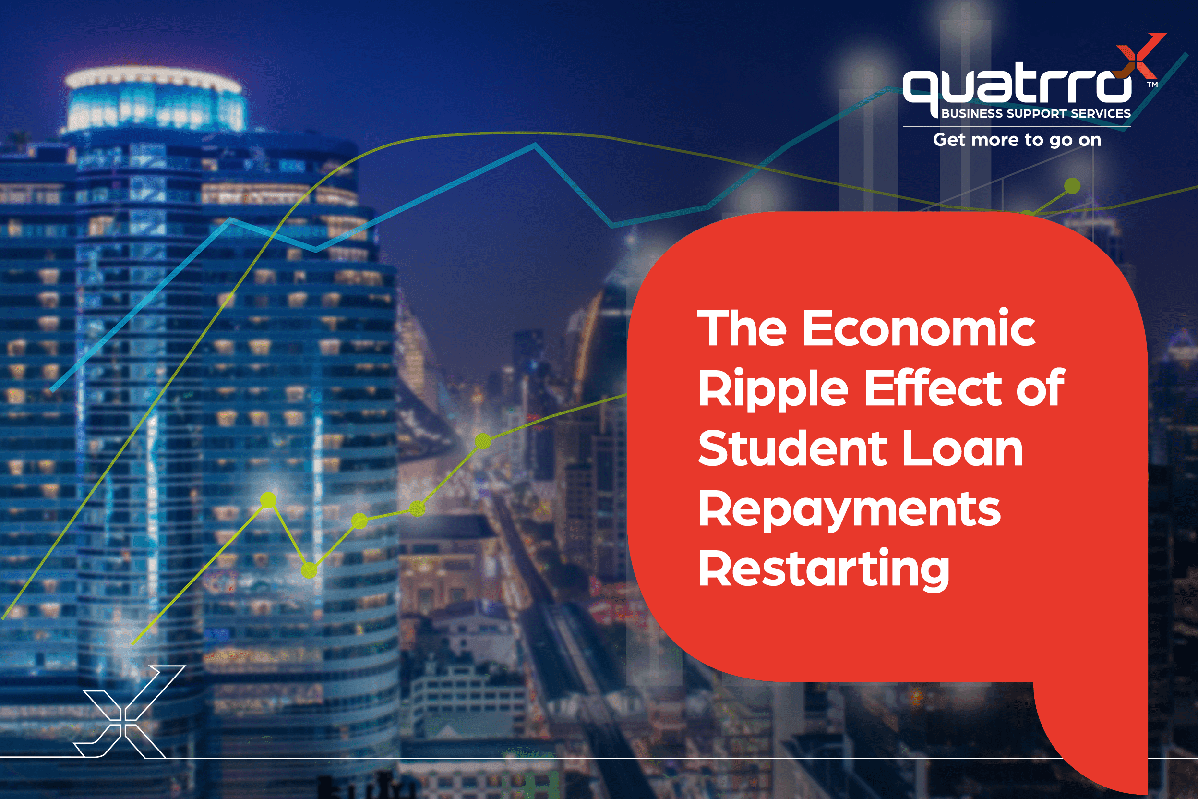Blog Details
The Economic Ripple Effect of Student Loan Repayments Restarting
November 21, 2023

Payments for federal student loans have restarted as of October 2023, after a three-year-long
pause. The change was finalized during negotiations on the recent debt ceiling bill, when house
republicans pushed for a clause that forbid the Department of Education from delaying
repayment any further. The pause has been extended nine times since March 2020, providing an
estimated $5 billion in relief every month.
While this change will have serious effects on student loan borrowers, there is a potential for
significant knock-on effects for various sectors of the economy.
Student Loan Borrowers May Default on Other Debts
As the cost of living continues to rise, many Americans have resorted to credit to keep up. The three-year pause raised the credit scores of many student loan borrowers, allowing them to take on more debt. 53% of student loan borrowers opened a new credit card during the three-year pause, with average credit card debt among them rising 12%. Unsecured consumer debt has now reached an all-time high of over $1.4 trillion. President Biden ran on a platform of student loan forgiveness, and according to surveys, his administration’s continued attempts at student loan forgiveness gave many borrowers the false hope that payments would not be resumed. Surveys show that 62% of student loan borrowers are unsure whether they can afford their monthly payments and are considering boycotting repayment altogether. The hope among many is that a boycott could pressure the government to consider debt forgiveness. While this may be futile — the federal government has both the power and the infrastructure necessary to garnish wages and tax refunds — it illustrates a general trend that businesses should be aware of. The average student loan borrower may be unable to afford payments on their collective debt. If they are forced to repay their student loans, they may be unable to make payments on any other debt they currently owe. Businesses that operate automotive and financial sectors should be aware of this risk and respond accordingly. Before student debt repayments resumed, defaults for car loans were already on the rise — the additional financial pressure may push them even higher.Effects of Decreased Disposable Income
With payments resuming, household budgets and disposable income for borrowers will shrink considerably. When surveyed, 18% of student loan holders say they find it difficult to buy daily necessities because of their student loans. With payments restarting, many may have to reconsider spending habits and budget intensively. When money is tight consumers usually categorize expenses into “wants” and “needs”. Businesses offering essentials such as food and rent may experience some effects, but will not be as heavily affected as businesses that offer luxury items or non-essential services. Industries like tourism, restaurants, and high-end retail may take a significant hit in their revenues as borrowers reallocate their spending toward necessities. Some businesses in the “want” category might also be spared the effects of a disposable income crunch among student loan borrowers. Studies show that during recessions, spending on more expensive “outside” entertainment decreases, but spending on “in-home” entertainment such as gaming or streaming services remains steady. It’s possible that this trend could be reflected in the behavior of student loan borrowers.Impact on Small Businesses
Small businesses often operate on thin margins and might find it difficult to adapt to a sudden decrease in customer spending. This, coupled with higher interest rates for business loans after Federal Reserve rate hikes, could be a dangerous combination. Sectors like local retail, hospitality, and service industries may be at greater risk and should do their best to prepare for possible difficulties up ahead.Impact on Housing Market
While student loan borrowers are 36% less likely than average to be able to purchase a home, there are still many student loan borrowers in the U.S. who either have a mortgage or are looking to purchase a home in the future. Payments restarting will make it more difficult for borrowers to pay off current loans and to qualify for mortgages in the future. This could negatively affect the housing market in the near future — a wave of defaults and decreased demand could cause prices to fall. However, there are a variety of other factors to consider, including high interest rates and the large number of homeowners unwilling to sell homes due to their current favorable 30-year mortgages and not wanting to get into a new mortgage at the new unfavorable rates. Businesses in the real estate sector may want to conduct a thorough risk assessment in their area before taking action.Employees May Look To Switch Jobs
Companies, particularly in sectors requiring high educational qualifications, may also find their employee relations strained. Skilled employees burdened by repayments might seek higher salaries or better benefits. If they are unable to do so at their current job, many may seek to move to another company. This is particularly relevant for the tech and healthcare sectors, where specialized skills are often coupled with high levels of student debt. Employers may find that offering student loan repayment benefits could be a differentiator in attracting and retaining top talent, even if this means reallocating funds from other perks or benefits.What Can Businesses Do To Adapt?
Given the potential impacts, businesses should consider a proactive approach now rather than a reactive one down the road. Here are some potential strategies for businesses across different industries:</tableBusinesses should take the opportunity to assess their vulnerabilities and adapt their strategies in
preparation for potential shifts in customer behavior.
 |
Risk AssessmentConduct a thorough risk assessment to understand how your specific sector may be impacted by the resumption of student loan repayments. Use this analysis to actively inform your business strategy. |
 |
Customer SegmentationRecognize that consumer behavior may change. Tailor your marketing and product offerings to be more budget-friendly, focusing on essentials rather than luxuries. |
 |
Employee BenefitsReevaluate your employee benefits packages to potentially include student loan repayment as a perk, particularly if you’re in sectors where educational qualifications are a prerequisite. |
 |
Credit ScoringIf you’re in the financial sector, adapt your credit scoring models to account for the increased risk of default among student loan borrowers. |
Latest Insights
Related Blogs
Contact Us








